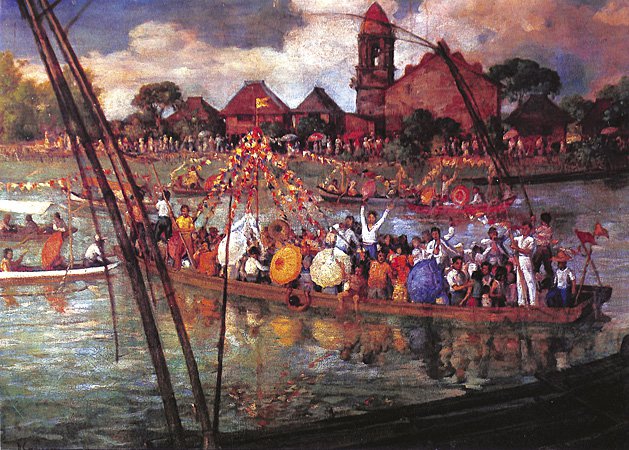Cultural Center of the Philippines
ENCYCLOPEDIA OF
PHILIPPINE ART
Fluvial Procession
1956 / Oil on canvas / 66.1 x 101.6 cm / Artist: Dominador Castañeda / Private collection.
The two greatest influences on Castañeda’s painting style were Fernando Amorsolo, his teacher during his formative years, and Western impressionism, which he absorbed in the course of his graduate work at the Art Institute of Chicago in the mid-1920s.
In Fluvial Procession, however, about the only thing Castañeda shares with his maestro is the choice of rustic subject matter. Gone are the backlighting and daubs of gentle yellows that characterized his Amorsoloesque years. Instead there is an almost total opaqueness in the canvas. The grayish blue of the sky, the cumulus white tinted with lavender and orange, the marshy greens of the water, and earthy brown of the architectural structure build up the dominant effect of this opaqueness. This is broken only by the glimmer of the water at the left and central portion of the landscape. An interplay of yellow, blue, white, and orange over the water’s shimmering viridian green is the painting’s raison d’être. A feeling of refreshing coolness results from this convincing rendition of wetness against a heavy, overcast sky.
The solidity of the nipa houses and church makes for a very stable, almost motionless picture, in spite of its subject, which is a community in celebratory action. The stillness is buttressed by the horizontality of the picture: boats crossing the water, and the greenish-black lines of another boat at the background, which is the vantage point of the scenery.
The clarity of the nipa houses and church at a distance contrasts with the obscurity of the human figures at the main boat, which are logically nearer. This is a deviation from the academic norm to which Castañeda used to adhere. The devotees—musicians, drinkers, rowers, children, and women with umbrellas in boats bedecked with banderitas (small flags)—are rendered in a rather naive manner, with daubs of paint concealing isometric structure.
Written by Imelda Cajipe-Endaya
